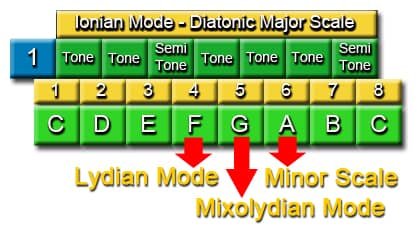MODAL SCALES: Ionian Mode
The Modal Scales or Greek Modes are based on the C major scale. This scale is called the Ionian Mode or Diatonic Major scale. Scale from which the rest of the modes would flow.
This modal scale would be similar to always dressing in the same suit, but changing the order when putting on the different clothes.
Aeolian Mode
For example, if instead of setting up the C Major scale as C – D – E – F – G – A – B – C, we set it up as A – B – C – D – E – F – G – A, we would go from key C Ionian mode or major scale, to key of A Aeolian mode or A natural minor scale.
Although the order of the intervals of each mode has varied, obtaining two different scales in two different keys, its structure is not altered, and both scales are made up of the same notes.
In the image below we will see it even more clearly. Below we see the C major scale and the A minor scale. As you can see, the structure is exactly the same for both scales. For this reason, the 6th note of a major key is called relative minor.
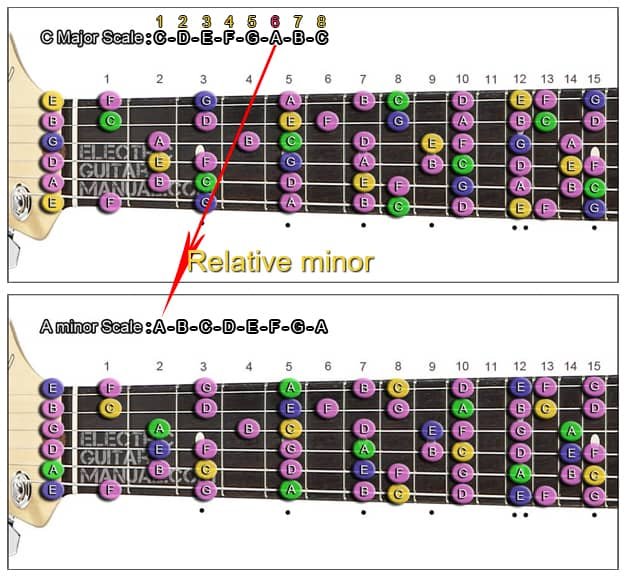

This would happen equally in all keys. For example, F Major scale is exactly the same as D minor scale. Since D is the 6th note of F major scale, or relative minor.
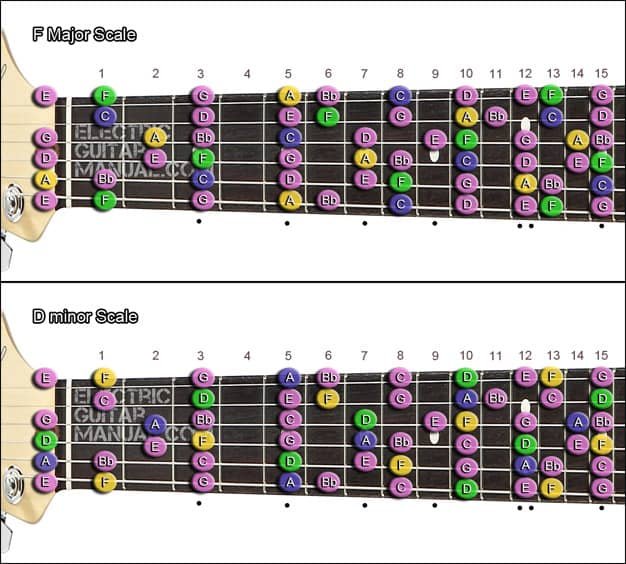
For example, if we know the situation of F Major scale, but we want to improvise a little on the song “Another Brick in the Wall” by Pink Floyd, which is in the key of D minor, we will think that we do not know that key. But it turns out that this scale has exactly the same notes as F Major. Since it is the relative minor of F, or 6th note of F major scale.
Although obviously the note D would be taken as the tonic note, instead of the note F. In other words, when doing a guitar solo, for example, we should end some of the beats on the note D (especially at the end of the solo), instead of F.
In fact, the song “Another Brick in the Wall” moves for a few moments within the Dorian mode. Later, when it comes time to talk about the Dorian mode, I will explain why this is so.
Diatonic Major Scale and Natural Minor Scale
The Ionian mode or major scale, and the Aeolian mode or natural minor scale, are the most used modes in modern music, and can be found in most songs, and in the most popular musical genres.
We would have five more modal scales left, since each mode would start from each of the seven notes of the major scale. For this reason the modes are also named by the note from which they would come in the tone of C.
For example, the Ionian mode or major scale is also known as the C mode. And the Aeolian mode or minor scale is known as A mode.
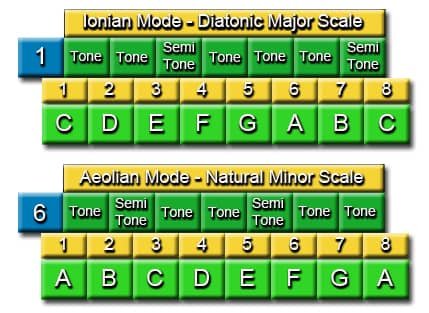
In order to learn the rest of the modal scales we will use the same technique, since each different mode is nothing more than starting the same scale, from another point.
MODAL SCALES: Mixolydian Mode
Another very popular modal scale is the Mixolydian mode or G mode, which would come from the 5th note of the major scale.
For example, if we take the 5th note of the C scale as the tonic, which would be G, we would be playing in the key G and Mixolydian mode. Since this mode would start from the 5th note of any major scale.
That is, if we want to play for example in E Mixolydian, we can use the structure of the A major scale, since E is the 5th note of the A Major scale.
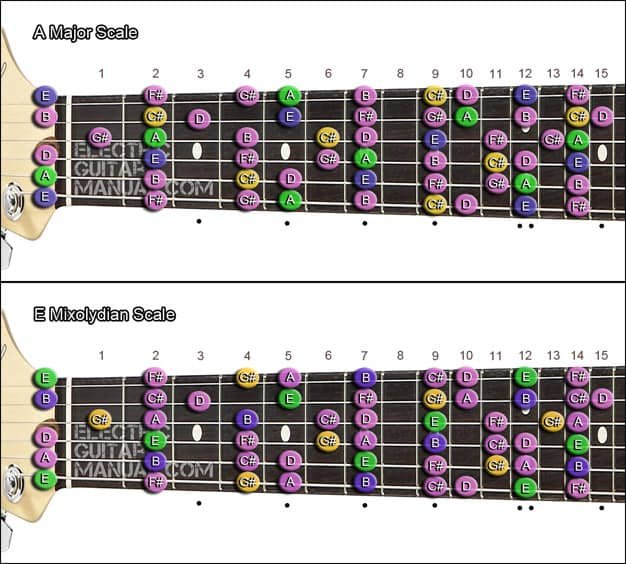
These concepts are simple to understand, but it takes some time to be able to handle them with agility.
The Mixolydian Mode is a Major mode, and the only difference from the Diatonic Major scale is that the 7th note is a semitone lower.
After the diatonic major scale and the natural minor scale, this would be the most important scale in terms of use, used in many musical genres such as Pop, Blues, Rock and alternative music.
Dorian Mode
The Dorian Mode or D mode is a minor mode, and the only difference that exists with respect to the natural minor scale is that the 6th note is a semitone higher. Mode used in genres such as Funk or Jazz.
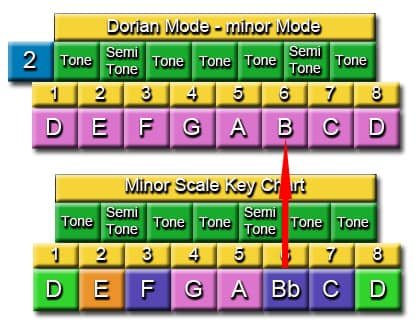
And as I already mentioned, also used in the song “Another brick in the Wall” by Pink Floyd.
As we already know in this song a G major chord is used. Something that is inconsistent with the key of D minor, since the G chord incorporates a note that does not belong to this key.
That note of the G chord that would come out of the key of D minor would be the note B. But it would fit perfectly in the Dorian mode, since the 6th note of Dorian mode is precisely one semitone higher than the minor scale.

So while the G Major chord is playing in the accompaniment of this song, we can introduce the note B in a small riff. Consequently, we will do something strange, effective, and we will look very good. Although Gilmour does not use this device, he plays the entire song’s solo in D minor.
If the accompaniment remained on the G Major chord for a certain time, we could directly use the G Major scale, for as long as this chord remains playing.
In fact, very complicated accompaniments are not very appropriate for improvisation. Simple and somewhat repetitive rhythms would be more convenient.
Phrygian and Ionian Mode
The Phrygian Mode or E Mode is also a minor mode, and its difference from the natural minor scale is that the 2nd note is a semitone lower. This mode has a jazzy feel.
The Lydian Mode or F Mode is a Major Mode and its difference from the Major scale is that the 4th note is a semitone higher. Mode used in Pop and alternative music.
The last mode we would have left would be the Locrio Mode or B Mode. This mode is not usually used in modern music. Although it is mainly part of Indian and Japanese music.
In short, each Major scale contains within itself a minor scale, defined by the 6th note of that scale. A Mixolydian mode defined by the 5th note, or for example a Lydian mode defined by the 4th note.
